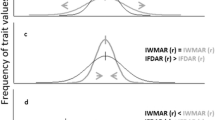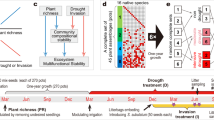Abstract
The essence of the contradiction between traditional ecological complexity-stability hypothesis and recent theoretical results is clarified. The distinction between resilience and resistance is stressed. The possibilities of field verification of May's model are discussed. No satisfactory method for estimation of connectance and mean interaction strength in plant communities has been found. Relation between these parameters and stability in real communities remains an open question. The relation between connectance and stability (resilience) in purely competitive model communities is more complicated than May's rule predicts. The certain value of connectance having been achieved, stability increases with increasing connectance. We assessed the positive relation between species diversity and resistance, and negative relation between species diversity and resilience in plant communities during old-field succession in xeric habitat. But there is no causal relationship between species diversity and both kinds of stability. Resistance and resilience of the plant communities studied were determined primarily by life history strategies of constituent species. The results are interpreted in terms of Grimes' life history strategies and imply the validity of Gleasonian, population-centered explanation of community phenomena.
Similar content being viewed by others
References
Abrams, P. A., 1981. Comparing randomly constructed and real communities: a comment. Amer. Natur. 188: 776–782.
Anderson, D. M. & King, C. C., 1978. A method for broad-scale environmental evaluation as applied in an environmental analysis of central Ohio. Ohio J. Sci. 78: 177–185.
Arnold, L., 1969. Zur asymptotischen Verteilung der Eigenwerte zufälliger Matrizen. Habilitationschrift, Universität Stuttgart, 82 pp.
Auclair, A. N. D., Bouchard, A. & Pajaczkowski, J., 1976. Productivity relations in a Carex-dominated ecosystem. Oecologia 26: 9–31.
Barnett, S. & Storey, C., 1970. Matrix methods in stability theory. Nelson, London. 148 pp.
Baumova, H., 1981. The influence of mowing on the vegetation structure of selected successional old-field stages. Thesis, Charles University, Praha, 85 pp. In Czech.
Berendse, F., 1979. Competition between plant populations with different rooting depths. Oecologia 43: 19–26.
Braakhekke, W. G., 1980. On coexistence: a causal approach to diversity and stability in grassland vegetation. Agric. Res. Rep. 902: 1–164.
Bureš, L., 1976. Pflanzengesellschaften der Brachfelder im Böhmischen Karst. Preslia 48: 21–32.
Czarnowski, M. S., 1978. Zarys ekologii roślin, l\cadowych. Państwowe Wydawnictwo Naukowe, Warszawa. 458 pp.
Drury, W. H. & Nisbet, I. C. T., 1971. Succession. J. Arnold Arboretum 54: 331–368.
Elton, C., 1958. The Ecology of Invasions by Animals and Plants. Methuen, London. 181 pp.
Fassatiová, O., 1978. Soil micromycetes in abandoned fields in Bohemian Karst. Česká Mykologie 32: 226–234.
Girko, V. L., 1980. Teorija slučajnych determinantov. Viša škola, Kiev. 367 pp.
Goh, B. S., 1979. Robust stability concepts for ecosystem models. In: E., Halfon (ed). Theoretical Systems Ecology, p. 467–487. Academic Press, London.
Goh, B. S., 1980. Management and Analysis of Biological Populations. Elsevier, Amsterdam. 288 pp.
Goh, B. S., Jennings, L. S., 1977. Feasibility and stability in randomly assembled Lotka-Volterra models. Ecol. Model. 3: 63–71.
Grime, J. P., 1979. Plant Strategies and Vegetation Processes. Willey, Chichester. 222 pp.
Harris, J. R. W., 1979. The evidence for species guilds is an artefact. Nature 279: 350–351.
Harrison, G. W., 1979. Stability under environmental stress: resistance, resilience, persistence, and variability. Amer. Natur. 113: 659–669.
Hill, M. O., 1973. Diversity and evenness: a unifying notation and its consequences. Ecology 54: 427–432.
Holling, C. S., 1973. Resilience and stability of ecological systems. Ann. Rev. Ecol. Syst. 4: 1–23.
Hopkins, B., 1978. The effects of the 1976 drought on chalk grassland in Sussex, England. Biol. Conserv. 14: 1–12.
Huhta, V., 1979. Evaluation of different similarity indices as measures of succession in arthropod communities of the forest floor after clearcutting. Oecologia 41: 11–23.
Huml, O., 1978. Allelopathy and change of dominants in the initial stages of succession. Thesis, Charles University, Praha. 74 pp. In Czech.
Hurd, L. E. et al., 1971. Stability and diversity at three trophic levels in terrestrial successional ecosystems. Science 173: 1134–1136.
Hulst, R.van, 1979. On the dynamics of vegetation: succession in model communities. Vegetatio 39: 85–96.
Jong, P.de, Aarssen, L. W. & Turkington, R., 1980. The analysis of contact sampling data. Oecologia 45: 322–324.
Kindlmann, P. & Rejmánek, M., 1982. Continuous vs. discrete models of multispecies systems: how much less stable are the latter ones? J. Theor. Biol. 94: 989–993.
Kindlmann, P., Lepš, J. & Rejmánek, M., 1982. complexity and stability of model competitive systems. J. Theor. Biol. (in press).
Klimková, N., 1977. Behaviour of phosphorus in the soil-vegetation-detritus system in selected old-field successional stages in Bohemian Karst. Thesis, Charles University, Praha, 128 pp. In Czech.
Knapp, R., 1977. Dauerflächen-Untersuchungen über die Einwirkung von Haustieren und Wild während trockener und feuchter Zeiten in Mesobromion-Halbtrockenrasen in Hessen. Mitt. flor.-soz. Arb.-Gemein. N.F. 19/20: 269–274.
Kosinová, J. & Rejmánek, M., 1979. Primary production and population structure of old-field plant communities in Bohemian Karst. Final Report, Dept. of Botany, Charles University, Praha. In Czech.
Lane, P. A., Lauff, G. H. & Levins, R., 1974. The feasibility of using a holistic approach in ecosystem analysis. In: S. A., Levin (ed.). Ecosystem Analysis and Prediction, p. 111–128. SIAM, Philadelphia.
Lawlor, L. R., 1978. A comment on randomly constructed model ecosystems. Amer. Natur. 112: 445–447.
Lawton, J. H. & Rallinson, S. P., 1979. Stability and diversity in grassland communities. Nature 279: 351.
Lepš, J., 1977. The development of horizontal structure of vegetation in the course of secondary succession. Thesis, Charles University, Praha, 158 pp. In Czech.
Lepš, J. & Prach, K., 1981. Simple mathematical model of the secondary succession of shrubs. Folia Geobot. Phytotax. 16: 61–72.
Maarel, E. van der & Werger, M. J. A., 1978. On the treatment of succession data. In: J. B. Faliński (ed.). Vegetation Dynamics. Phytocenosis 7: 257–278.
MacDonald, N., 1978. Complexity and stability. Nature 276: 117–118.
Margalef, R., 1968. Perspectives in Ecological Theory. Univ. Chicago Press, Chicago 111 pp.
Margalef, R., 1974. Ecologia. Omega, Barcelona. 951 pp.
Marks, P. L., 1974. The role of the pin cherry (Prunus pensilvanica L.) in the maintenance of stability in northern hardwood ecosystems. Ecol. Monogr. 44: 73–88.
May, R. M., 1972. Will a large complex system be stable? Nature 238: 413–414.
May, R. M., 1973. Stability and Complexity in Model Ecosystems. Princeton Univ. Press, Princeton. 235 pp.
May, R. M., 1976. (ed.) Theoretical Ecology. Blackwell, Oxford. 317 pp.
May, R. M., 1979. The structure and dynamics of ecological communities. In: R. M., Anderson, B. D., Turner & L. R., Taylor (eds.). Population Dynamics, p. 385–407. Blackwell, Oxford.
McIntosh, R. P., 1980. The relationship between succession and the recovery process in ecosystems. In: J., CairnsJr. (ed.). The Recovery Process in Damaged Ecosystems, p. 11–62. Ann Arbor Science Publ. Ann Arbor.
McNaughton, S. J., 1978. Stability and diversity of ecological communities. Nature 274: 251–253.
McNaughton, S. J., 1979. Stability and diversity in grassland communities — a reply. Nature 279: 351–352.
McNaughton, S. J. & Wolf, L. L., 1973. General Ecology. Holt, Rinehart & Winston, New York. 710 pp.
Melinger, M. V. & McNaughton, S. J., 1975. Structure and function of successional vascular plant communities in central New York. Ecol. Monogr. 45: 161–182.
Mestenhauserová, M., 1979. The role of phosphorus in the ecosystems of selected stages of secondary succession. Thesis, Charles University, Praha, 186 pp. In Czech.
Michálek, J., 1979. The stability of secondary succession stages and the effect of herbicides. Thesis, Charles University, Praha, 124 pp. In Czech.
Miles, J., 1979. Vegetation Dynamics. Chapman & Hall, London. 80 pp.
Nunney, L., 1980. Density compensation, isocline shape and single-level competition models. J. Theor. biol. 86: 323–349.
Odum, E. P., 1969. The strategy of ecosystem development. Science 164: 262–270.
Odum, E. P., 1971. Fundamentals of Ecology. Saunders, Philadelphia. 574 pp.
Orians, G. H., 1974. Diversity, stability, and maturity in natural ecosystems. In: W. H.van, Dobben & R. H., Lowe-McConnell (eds.), Unifying Concepts in Ecology, p. 139–150. Junk, The Hague.
Orlóci, L., 1978. Multivariate Analysis in Vegetation Research. Junk, The Hague. 2nd ed. 451 pp.
Pimm, S. L., 1979. The structure of food webs. Theor. Popul. Biol. 16: 144–158.
Poole, R. W., 1974. An Introduction to Quantitative Ecology. McGraw-Hill, New York. 532 pp.
Post, W. M., Shugart, H. H. & DeAngelis, D. L., 1978. Stability criteria for multispecies ecological communities. Oak Ridge Nat. Lab. Tech. Mem. 6475.
Post, W. M. & Travis, C. C. 1979. Quantitative stability in models of ecological communities. J. Theor. Biol. 79: 547–553.
Prach, K., 1981. Selected characteristics of shrubby successional stages of abandoned fields in the Bohemian Karst. Preslia 53: 159–169.
Rambousková, H., 1980. Water dynamics of some abandoned fields of the Bohemian Karst (Czechoslovakia). Folia Geobot. Phytotax. 15: 369–385.
Rauch, O., 1978. Some aspects of stability of two old-field successional stages in Bohemian Karst. Thesis, Charles University, Praha, 117 pp. In Czech.
Rejmánek, M., 1977. The concept of structure in phytosociology with references to classification of plant communities. Vegetatio 35: 55–61.
Rejmánek, M., 1979. Stability and complexity in biotic communities: theoretical and empirical approach. In: M., RužičKa (ed.). Proc. 5th Intern. Symp. Probl. Ecol. Land. Res., p. 65–72. SAV, Bratislava.
Rejmánek, M., 1981. Corrections to the indices of community dissimilarity based on species diversity measures. Oecologia 48: 290–291.
Rejmánek, M. & Jeník, J., 1978. Biogeochemical cycles: phosphorus problem. In: B., Moldan & Pačes (eds.). Biogeochemical Cycle in Countryside, p. 60–64. Geological Survey, Praha.
Rejmánek, M. & Starý, P., 1979. Connectance in real biotic communities and critical values for stability of model ecosystems. Nature 280: 311–313.
Smedes, G. W. & Hurd, L. E., 1981. An empirical test of community stability: resistance of a fouling community to a biological patch forming disturbance. Ecology 62: 1561–1572.
Snaydon, R. W., 1979. A new technique for studying plant interactions. J. Appl. Ecol. 16: 281–286.
Sousa, W. P., 1980. The responses of a community to disturbance: the importance of successional age and species life histories. Oecologia 45: 72–81.
Svirežev, Ju. M. & Logofet, D. O., 1978. Ustojčivost biologičeskich soobščestv. Nauka, Moskva. 352 pp.
Sykora, K. V., 1979. The effects of the severe drought of 1976 on the vegetation of some moorland pools in the Netherlands. Biol. Conserv. 16: 145–162.
Wchster, J. R., Waide, J. B. & Patten, B. C., 1975. Nutrient recycling and the stability of ecosystems. In: F. G., Howell (ed.). Mineral Cycling in Southeastern Ecosystems, p. 1–27. ERDA Symp. Ser. CONF-740513. Natl. Tech. Inf. Serv. Springfield.
Westman, W. E., 1978. Measuring the inertia and resilience of ecosystems. BioScience 28: 705–710.
Wigner, E. P., 1967. Random matrices in physics. SIAM Rev. 9: 1–23.
Willems, J. H. 1980. Observations on north-west European limestone grassland communities. Proc. Koninklijke Nederl. Aked. Wetensch. Ser. C. 83: 279–306.
Whittaker, B. H., 1970. The population structure of vegetation. In: R., Tüxen (ed.). Gesellschaftsmorphologic, p. 39–59. Junk, The Hague.
Yodzis, P., 1978. Competition for Space and the Structure of Ecological Communities. Springer. Berlin. 191 pp.
Yodzis, P., 1980. The connectance of real ecosystems. Nature 284: 544–545.
Author information
Authors and Affiliations
Additional information
The nomenclature of plants follows F. Ehrendorfer, 1973, Liste der Gefässpflanzen Mitteleuropas, 2. Aufl. G. Fischer, Stuttgart.
Acknowledgements. We thank Pavel Kindlmann for helpful discussion. We are also grateful to reviewers for suggesting ways to improve this paper.
Rights and permissions
About this article
Cite this article
Lepš, J., Osbornová-Kosinová, J. & Rejmánek, M. Community stability, complexity and species life history strategies. Vegetatio 50, 53–63 (1982). https://doi.org/10.1007/BF00120678
Accepted:
Published:
Issue Date:
DOI: https://doi.org/10.1007/BF00120678




